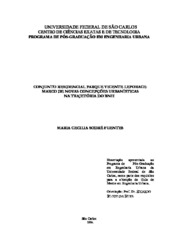Conjunto residencial Parque Vicente Leporace: marco de novas concepções urbanísticas na trajetória do BNH.
Abstract
This work analyses the urban project of a housing sets named Parque Vicente
Leporace. It is situated in the city of Franca, Sao Paulo State, developed by CECAP, at the
end of the 70`s. The project methodology and the context are related to the historic process of
arrangement the governmental policies to provide houses for worker in the country.
It is distinguished from the others because of its great proportions and for
having an urban project that is not traditional and very different, and which can be considered
an example of the last phase of urban policy of National Housing Bank BNH-. Its
importance lies in the particular characteristics of the project and the way it was implemented
step by step.
The construction of houses polarised a population of 15 thousand people,
which means, they almost built a new town, which has a specific identity inside the city of
Franca. It encouraged an urban expansion in that region whose main inhabitants were workers
and people from the underclass, giving this place character and importance as a sub urban
centre.
The urban project was a result of urban majority thoughts during the BNH
housing politicies and CECAP structuring at that time. There had already existed a
provisional plan about the problems of product a social state housing in the country. The
housing policies had decisive moments with crises sights and in the professional course tried
to find solutions to urban problems of the housing sets.
